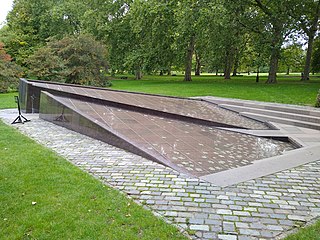 W
WThe African and Caribbean War Memorial in Brixton, London, is the United Kingdom's national memorial to African and Caribbean service personnel who fought in the First and Second World Wars. It originated with a project for a memorial to Caribbean Royal Air Force veterans of World War II who arrived in Britain in 1948 on the MV Empire Windrush; this was an extension of the commemorative plaque and sculpture scheme run by the Nubian Jak Community Trust to highlight the historic contributions of Black and minority ethnic people in Britain. The memorial was originally to have been placed at Tilbury Docks, as part of the commemoration for the centenary of the outbreak of World War I. However, as the project began to evolve into a larger tribute that included both World Wars and commemorated servicemen and women from both Africa and the Caribbean, it was agreed by the memorial recipient – the Port of Tilbury – and the project organisers that a new, more accessible location needed to found. The memorial was ultimately permanently installed and unveiled on 22 June 2017 in Windrush Square, Brixton.
 W
WThe Canada Memorial in Green Park, London, United Kingdom, commemorates members of the Canadian Forces killed during the First and Second World Wars. It was designed by the Canadian sculptor Pierre Granche, erected in 1992 and unveiled by Queen Elizabeth II in 1994. The memorial was the result of lobbying and fund raising, much of it in Canada, by the former Canadian media tycoon Conrad Black.
 W
WThe Cenotaph is a war memorial on Whitehall in London, England. Its origin is in a temporary structure erected for a peace parade following the end of the First World War, and after an outpouring of national sentiment it was replaced in 1920 by a permanent structure and designated the United Kingdom's official national war memorial.
 W
WThe County Fermanagh War Memorial stands in Enniskillen, County Fermanagh, Northern Ireland. It was originally constructed to commemorate the men of the town killed during the First World War, particularly those serving with the local regiments, the 6th (Inniskilling) Dragoons and the Royal Inniskilling Fusiliers. It was later altered to also commemorate those killed in the Second World War.
 W
WThe Cyclists War Memorial is a war memorial on the village green in Meriden, West Midlands. The village between Coventry and Birmingham was long reputed to be at the geographical centre of England. The national memorial was built in 1920 to commemorate cyclists killed in the First World War. A bronze plaque was added in 1963 to commemorate cyclists killed in the Second World War.
 W
WErected in 1927, the Diamond War Memorial is located on The Diamond in the centre of Derry, County Londonderry, Northern Ireland. It is dedicated to the citizens of the city who lost their lives while in military service during World War I.
 W
WThe East Knoyle War Memorial is a monument that commemorates the lives of soldiers from East Knoyle, Wiltshire, England, who were killed in war. Unveiled on 26 September 1920, it was originally intended to commemorate the 20 soldiers from the parish who died during the First World War. Subsequent inscriptions were added to recognise twelve who were killed in the Second World War, and a soldier killed by friendly fire in the Iraq War. In 2016 the memorial was designated a Grade II listed building.
 W
WHendon War Memorial in Hendon, North London is located on the central reservation at the junction between Watford Way and The Burroughs. It was unveiled on St George's Day, 23 April 1922, but was moved to its present location in 1962.
 W
WLeckhampstead War Memorial is a Grade II listed war memorial in Leckhampstead, Berkshire, which commemorates 89 local men who served in the First World War, including 17 war dead. The names of two more war casualties were added after the Second World War.
 W
WMargravine Cemetery, also known as Hammersmith Cemetery, is in the London Borough of Hammersmith and Fulham. The closest London Underground station is Barons Court.
 W
WThe Monmouth War Memorial commemorates the Monmouth fallen of the First and Second World Wars.
 W
WThe Parliamentary War Memorial, also known as the Recording Angel Memorial, is a stone sculpture in Westminster Hall, unveiled in 1922, which commemorates the members of both Houses of Parliament of the United Kingdom who died in the First World War. It names 22 members of the House of Commons, 20 members of the House of Lords, and 9 senior members of staff, together with another 94 sons of members and officers of the House of Commons, who lost their lives in the war. Above the memorial is a large stained glass window which commemorates members and staff of both Houses who died in the Second World War.
 W
WThe Portland Cenotaph is a war memorial located on the Isle of Portland, Dorset, England. It is situated at New Ground, looking down to Underhill of the island and overlooking Chesil Beach, as it sits in front of Portland Heights Hotel. The monument is dedicated to the local soldiers who died during both the First and Second World Wars. It has been a Grade II Listed Monument since May 1993.
 W
WThe War Memorial of the Royal Monmouthshire Royal Engineers commemorates the soldiers who died in World War I and World War II.
 W
WThe Welch Regiment War Memorial, also known as the Maindy Monument is a First World War memorial at Maindy Barracks in the Cathays area of Cardiff in Wales. The memorial was designed by Sir Edwin Lutyens and follows his design for the Cenotaph on Whitehall in London. Unveiled in 1924, it commemorates men of the Welch Regiment who fell in the First World War, and is today a grade II listed building.